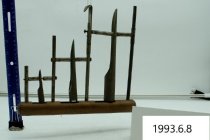Object Record
Images


Metadata
Catalog Number |
1993.06.08 |
Object Type |
Chime, Musical |
Creator |
J. C. Deagan, Inc. |
Title |
Angklung |
Description |
Triple octave Angklung, made of cast aluminum. Eb pitch. Made in 1902 by J.C. Deagan Co. Part of a five octave set. Gifted to Emil Richards in 1969. Generally, known as "Shaker Chimes" by Deagan, this aluminum version is sold as an "Aluminum Chime". |
Dimensions |
H-10.5 W-11 D-1.5 inches |
People |
J. C. Deagan, Inc. |
Date |
1902 |
Additional Research |
Angklung are idiophonic instruments native to Indonesia. Traditionally, large numbers of them are shaken for ceremonial dances. They can also be played by a group of musicians, each of whom has one instrument of differing pitch in each hand. The entire group performs a single melody in much the same way as a handbell choir, with each performer shaking an angklung at the appropriate time in the melody. Each angklung consists of two or three bamboo tubes of differing lengths tuned in octaves. The tubes are mounted in a frame so that a slot on each tube aligns into a cross-piece that strikes the tube when the instrument is shaken. Carl Orff included unpitched angklung in his "Catulli Carmina" and "Weihnachtsspiel," and scored "Prometheus" for two angklung pitched in G-flat and B-flat. In the early 20th century, J.C. Deagan developed an American version, called Organ Chimes or Aluminum Chimes, constructed from metal. When mounted on a rack, which allowed one or two people to perform solo pieces, Deagan's Organ Chimes became a popular novelty instrument for vaudeville and radio shows. Percussive Notes, April 1998. Angklung Indonesia Angklung are generally used to accompany ceremonial dances. They produce a pitched, rattling sound when shaken. Large ensembles of angklung are played by groups of musicians, each of whom has one instrument of distinct pitch in each hand. The members of the anngklung orchestra are each responsible for only two notes of the complex melodic linc. The angklung consists of two or three bamboo tubes of specific length tuned in octaves. These tubes are mounted in a frame so that a slot on each tube aligns into a cross-piece that strikes the section of bamboo when the instrument is shaken. Included in this display are a set of chromatic angklung mounted so they can be played by a single person, a large bass angklung, and an aluminum chime based on the angklung design that was manufactured by the J.C. Deagan Company in the early twentieth century. Donated by Emil Richards PAS Museum Exhibit Label |
Credit line |
Gift of Emil Richards |
